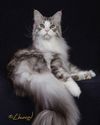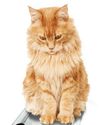
Recently, a judge told an exhibitor at a show that her blue lynx point Siberian kitten appeared to be a blue-silver lynx point. Calling attention to the white banding at the roots of the kitten’s fur, the judge suggested that a change be made to its color description.
Although extremely knowledgeable about genetics, the exhibitor (an experienced dog breeder), was somewhat rattled by her first “Owner?” call to the ring. She immediately contacted the breeder, who told her that silver was impossible: Neither parent was silver, and the white must have come from the kitten’s white spotting. “Did you change the color?,” the breeder asked. “No,“ was the reply. The breeder resolved to pursue the color issue with the judge herself at the earliest opportunity.
However, word soon came that a second judge had questioned the kitten’s color. The perceived color was the same—blue-silver lynx point. The breeder was quite puzzled. Both judges were very experienced and knowledgeable about color genetics and had independently come to the same conclusion about the kitten’s color. Surely they were just seeing the white spotting?
The breeder then had a sudden realization: There was actually no white spotting trait involved! The kitten being shown was registered as a blue lynx point and had very dark paw pads. It was his sister—who had been sold as pet—who had white paws. So, there was definitely some issue with the pedigree. The breeder owned both parents, and neither one was a silver … or WAS it?
“Hi, Ho, Silver?”
This story is from the February 2024 edition of Cat Talk.
Start your 7-day Magzter GOLD free trial to access thousands of curated premium stories, and 9,000+ magazines and newspapers.
Already a subscriber ? Sign In
This story is from the February 2024 edition of Cat Talk.
Start your 7-day Magzter GOLD free trial to access thousands of curated premium stories, and 9,000+ magazines and newspapers.
Already a subscriber? Sign In

Life With Patrick
Patrick and Mount Doom

Feline Photographers Part 1
\"Cats never strike a pose that isn't photogenic.\" - Lillian Jackson Braun

The Cat Fancy Alphabet
\"The Cat Fancy Alphabet\" is a new feature in Cat Talk. It highlights various terms and aspects of the cat fancy, educating fanciers new and old about our hobby.

UP CLOSE AND Purr-sonal
If there is one person, or even just a name, that anyone in CFA (Cat Fancier Association) knows, it would have to be Allene Tartaglia. It might be from her involvement with most aspects of the operations of CFA in her position of executive director. Or perhaps from her deep involvement with both the CFA Annual meeting and/or the International Show. Cat Talk thought it was time to learn more about one of the most key people in CFA.

Vision and Hearing Dysfunctions in Senior Cats
Just as people are challenged by having deficiencies with vision and hearing over time, so are senior cats. In senior cats, pet owners may notice their cats are no longer responding to them in the same way; however, it may be difficult to figure out.

Senior Cats and House Soiling
Why is my cat no longer using its litter box? Cat soiling in the house is one of the most talked about issues for pet owners.

Nutrition for Our Senior Cats
From the time they are born, our kittens receive a tremendous amount of care, with diet being at the core of their growth and development.

Fluffy's Sixteen and STILL Plays Like a Kitten!
Enrichment for Senior Cats

Alternative Arthritis Treatments for Cats
Just like humans, cats can experience arthritis. About 90% of cats over the age of 10 years experience osteoarthritis (OA) in at least one joint.1 It is a complex condition involving inflammation and degeneration of one or more joints and is sometimes referred to as degenerative joint disease (DJD). Cats with OA experience pain and inflammation in various joints that interfere with daily activities.

Checklist For What to Look For in Your Club's Next Show Venue
Show Manager To Ring One, Please